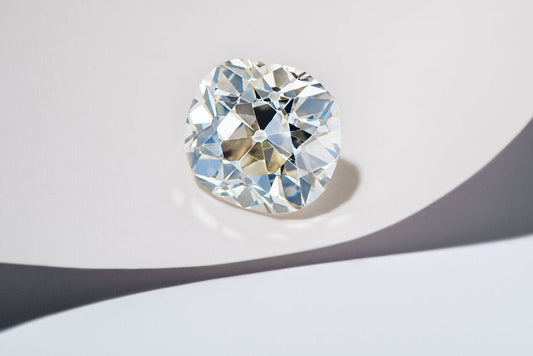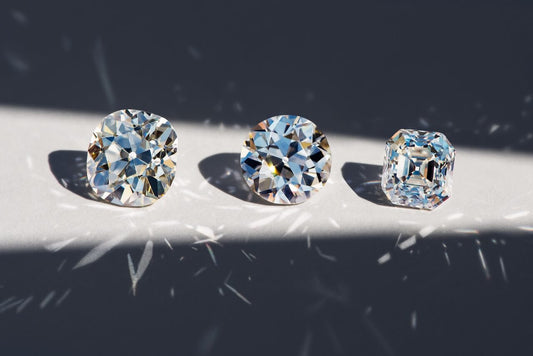Before diamonds were cut by lasers and machines, they were cut by skilled artisans. Every antique diamond was assessed by eye and cut by hand with one simple, yet difficult goal: to enhance its beauty. Sadly, the skill of cutting a diamond as an art form has been lost as technology has advanced. With the commoditisation of diamonds came the “4 C’s” and an increased obsession with the certificate and the value of the diamond—often at the expense of beauty and the artistic expression of the diamond cutter. Many antique diamonds offer a superior quality of fire and brightness. All of them are one of a kind and imbued with history and meaning.
Here are the six top reasons why antique diamonds are the perfect choice for those seeking inimitable charm and timeless appeal.
01 — BEAUTY
Antique diamonds were cut for beauty rather than carat weight retention, meaning they are often much brighter and have a lot more “fire” than modern cut diamonds.
02 — TRULY ONE OF A KIND
Antique diamonds were measured by eye and cut/polished by hand by one diamond cutter, giving each stone a unique character and charm. Modern cut diamonds are precision cut using new technologies (such as computers and lasers) and are therefore very uniform in appearance.
03 — SOFTER LIGHT RETURN
The cutting style of antique diamonds gives larger facets and blockier, softer light return. This creates a sophisticated and romantic appearance. Modern cut diamonds tend to have a more “blingy” and uniform appearance.
04 — VINTAGE APPEAL
Antique diamonds are steeped in history. Each one holds a unique story and has a unique character
05 — RARITY
Genuine antique cut diamonds are very rare as over the years the majority have been recut into modern cut diamonds.
06 — ECO-FRIENDLY
Antique diamonds are repurposed, as opposed to newly mined, making them a more environmentally conscious and sustainable choice.

HAMISH WHITING’S THREE TOP TIPS FOR BUYING AN ANTIQUE DIAMOND
Hamish is our Gemological Institute of America (GIA) trained gemologist and HRD Antwerp diamond grader, and our in-house rock expert. He is currently working from the Antwerp Diamond Bourse—the centre of old-world diamond trading. Here are his top tips for buying an antique diamond.
01 — MAKE SURE IT'S A GENUINE ANTIQUE, NOT AN “ANTIQUE-STYLE CUT”
There are many companies cutting modern diamonds in an antique style and marketing them as "antique diamonds" which is very misleading.
Modern cutting techniques can replicate, to some degree, the style of an antique cut but most fall short in beauty due to the pressures to retain carat weight. It’s usually very easy to differentiate a modern cut “antique-style” diamond from a genuine antique diamond due to their thicker, faceted girdles and lower crown height (modern diamonds are cut very flat so that no carat weight is “wasted”).
Unfortunately, there is no certification for genuine antiques to differentiate them from replica antiques. This is why you need to buy from an experienced dealer of antiques who’s had experience looking at hundreds of genuine antiques to know the difference. It's like differentiating a genuine artwork or piece of furniture, from a replica—it takes a highly-trained eye. For example, modern cut antiques are generally still cut very shallow (for carat weight retention), and the machinery used to cut genuine antiques in the past was very different (skilled artisans who cut by hand as opposed to computers and laser technology), so they have different qualities which are extremely difficult to replicate now.
02 — LOOK FOR DIAMONDS THAT ARE “WARMER” IN COLOUR
The majority of antique diamonds fall in the I-J-K colour grades, or even warmer. This is partly because most of the rough diamonds at that time came from mines that produced warmer-coloured diamonds, and also because the majority of colourless antique diamonds (grade D-H) have been recut over the years into modern brilliant diamonds. High colour grade antique diamonds do exist, but they are much rarer and are priced at a premium.
Although antique diamonds are generally warmer in colour, in the case of well cut antiques, they often “face up whiter” than a modern diamond, which tends to be less forgiving. In other words, a K colour antique diamond can appear more like a J or even I colour, while a J colour in a modern diamond will be visibly warmer.
DIAMOND TERMINOLOGY:
Face up white: A diamond that “faces up white” or “faces up whiter” is a diamond that appears white when looking at it from the top down. This is the vantage point most people will see your diamond from when it is set. You may see some colour in diamonds that “face up whiter” when viewing them from side on.

03 — DON’T FIXATE ON THE CERTIFICATE. LOOK AT THE DIAMOND WITH YOUR EYES.
Antique diamonds will not be “perfect on paper” like modern cut diamonds might. GIA certificates did not exist back then, and the mentality of diamond cutting was completely different. Diamonds were cut for beauty, rather than the “4C’s” on the certificate.
Antique diamonds were measured by eye and cut by hand, so they’re less precise and symmetrical than modern diamonds and cannot be judged in the same way. It’s normal to see asymmetrical facets, as well as other minor quirks of the hand-cutting process. For this reason, their symmetry grades are more likely to be “Good” on a certificate.
Also, due to the wear and tear of being worn and knocked about for 100 years or more, antique diamonds will have small abrasions and nicks which will affect the polish grade (i.e Fair-Good). While we could easily polish out these flaws so that the diamond could get a higher grade on paper, this would remove all the evidence of the stone being a genuine antique diamond. Therefore, if the abrasions on the diamond are not visible to the naked eye, they are left untouched so that we can retain the evidence that it's a genuine antique cut.
For many people, part of the appeal and character of an antique diamond is its imperfections and unique character. Since modern diamonds are measured and cut using advanced technology, they don’t possess the “fingerprint” of the cutter and in comparison lack unique charm and character.
IN SUMMARY
Just like with modern cut diamonds, there are many pitfalls for the inexperienced buyer to stumble into. You are never protected by a GIA grade. It is critical to work with an experienced expert in buying both antique diamonds and modern cut diamonds.
MAKE IT YOURS
Explore our highly-coveted range of antique diamonds. Book an appointment with a CUSHLA WHITING Design and Gemstone Consultant.
BOOK APPOINTMENT


